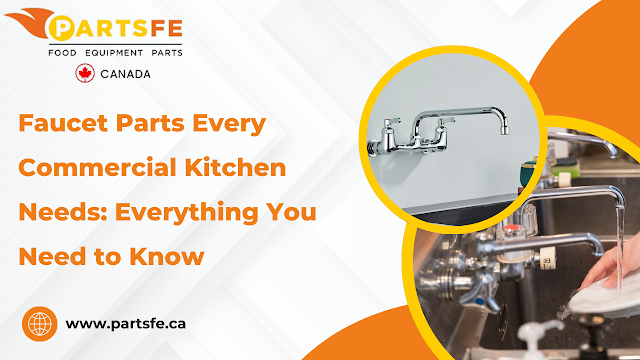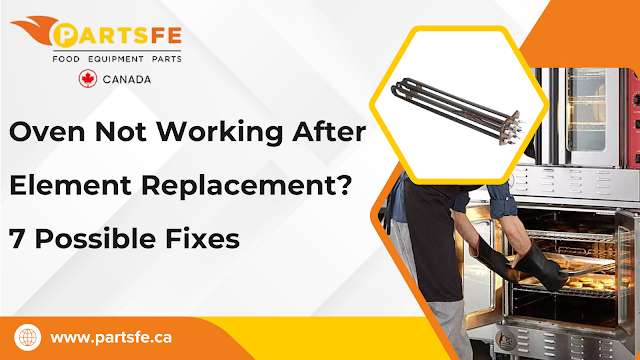Faucet Parts Every Commercial Kitchen Needs: Everything You Need to Know
A well-functioning faucet system is essential for maintaining hygiene and efficiency in any commercial kitchen. Faucets are used constantly for cleaning, food prep, and sanitation, making their components vital to efficiency and safety. From sprayer heads to cartridges and gaskets, each part plays a key role in performance and durability. Understanding these essential components can help prevent unexpected breakdowns and costly downtime. In this guide, we’ll cover the faucet parts every commercial kitchen needs and how they contribute to a more reliable and productive work environment.
Understanding the Faucet Components in a Commercial Kitchen
Commercial kitchens are high-demand environments that require plumbing systems to withstand constant use, harsh cleaning chemicals, and quick transitions. A failing faucet or a leaky valve can disrupt operations, lead to sanitation issues, or cause safety hazards.
Therefore, understanding the key components of your faucet system helps maintain efficiency and extends the life of your kitchen equipment.
Essential Faucet Parts:
Pre-Rinse Unit
A pre-rinse unit is a high-pressure sprayer connected to a flexible hose. It is normally used to wash food debris off dishes before they enter the dishwasher.
Why is it Essential
Speeds up dishwashing operations
Reduces water usage as compared to traditional methods.
Made for heavy-duty and high temperatures
Key Parts:
Hose and spring assembly
Spray valve
Wall bracket for stability.
Tip: Choose a pre-rinse unit with a flow rate of 1.15–1.6 GPM (gallons per minute) for water efficiency without sacrificing power.
Faucet Cartridges & Valve Stems
Cartridges or valve stems control water flow and temperature by regulating how much hot or cold water enters the spout. These are the internal "brains" of the faucet.
Why it’s Essential:
Prevent leaks and drips
Allow for consistent temperature control
Ensure compliance with health codes by preventing cross-contamination of hot and cold water
Ceramic (durable and corrosion-resistant)
Brass (commonly used for longevity)
Note: Worn-out cartridges are a top cause of faucet failure in commercial kitchens. Keep replacements on hand to avoid downtime.
Aerators
An aerator is a small mesh screen attached to the faucet spout, mixing air with water to create a smooth flow.
Why it’s Essential:
Reduces water splashing
Saves water without reducing pressure
Filters out debris that may clog the faucet
In high-volume kitchens, low-flow aerators (0.5–1.5 GPM) are often used to maintain health code standards and minimize water waste.
Swivel Spouts & Gooseneck Spouts
Spouts are the part of the faucet where water exits. Swivel and gooseneck designs are common in commercial settings.
Key Features:
Swivel spouts rotate 360°, ideal for filling multiple sinks or large pots.
Gooseneck spouts offer extra clearance, which is especially useful when washing large equipment.
Why it’s Essential:
Increases flexibility and efficiency
Helps avoid cross-contamination
Reduces the risk of damaging cookware or dishes
Handles: Lever, Wrist Blade, or Sensor-Activated
Choosing the right handle type enhances usability, hygiene, and compliance in a busy kitchen environment. Each option offers unique benefits tailored to specific tasks and accessibility needs.
Handle Types:
Lever Handles: Standard and easy to use, even with wet or greasy hands.
Wrist Blade Handles: Designed for hands-free use—staff can operate them with their wrists or forearms.
Sensor Faucets: Touch-free technology is ideal for handwashing stations.
Why Handle Type Matters:
Improves hygiene by limiting contact
Complies with ADA and NSF standards
Enhances usability during busy kitchen hours
Choose handle types based on the faucet’s purpose—sensor models for handwashing, lever or wrist blades for dishwashing stations.
Vacuum Breakers & Backflow Preventers
Vacuum breakers and backflow preventers are safety devices that stop contaminated water from flowing back into the clean water supply.
Why it’s Essential:
Essential for meeting health and plumbing codes
Protect water supplies from grease, soap, and food waste
Often mandatory in pre-rinse units and mop sinks
Pro Tip: Check your local plumbing codes, as some jurisdictions require dual-check valves or atmospheric vacuum breakers in all commercial faucets.
Faucet Flanges and Mounting Kits
These parts connect your faucet securely to the sink or wall, ensuring proper alignment and leak prevention.
Mounting Types:
Deck-Mounted: Installed on the sink or countertop.
Wall-Mounted: Ideal for saving counter space and for easier cleaning.
Benefits:
Maintains faucet stability under heavy use
Prevents loosening over time
Supports proper water flow and drainage
Hose Reels and Add-On Faucets
Hose Reels: Perfect for cleaning floors, washing produce, or filling containers away from the sink. They retract automatically, helping maintain a clutter-free workspace.
Add-On Faucets: Attached to pre-rinse units or standard spouts, allowing for multi-tasking such as filling pots while rinsing dishes.
Both tools are vital in maximizing productivity and space usage in tight or high-traffic kitchens.
Spray Valves
Heavy-duty nozzles are used in conjunction with pre-rinse units to direct a strong, focused stream of water.
Benefits:
Conserves water (most operate at 1.15 GPM or less)
Increases dishwashing efficiency
Durable construction stands up to repeated use
Choose models that are NSF-certified and include easy-pull levers for ergonomic operation.
Choosing the Right Faucet Parts for Your Kitchen
Upgrading kitchen faucets means balancing durability, safety, and efficiency. Use this quick guide to pick reliable, high-performance parts that meet commercial standards.
Material Quality: Opt for brass or stainless steel for long-lasting performance and strong resistance to rust and corrosion.
NSF Certification: Ensure components are NSF-certified to meet strict health, hygiene, and safety regulations in commercial kitchens.
Water Efficiency: Select EPA WaterSense-labeled parts to reduce water usage without sacrificing pressure or performance.
Interchangeability: Go for brands with common fittings and parts so that the replacements will be easy to find and install when needed.
Warranty and Support: Choose parts from trusted manufacturers that offer warranties and dependable customer service for long-term value.
Preventive Maintenance Tips for Ensuring Longevity of Faucet Parts
Regular maintenance is key to extending the life of your faucet parts and avoiding costly repairs. Simple preventive steps can keep your commercial kitchen running smoothly and efficiently.
Inspect leaks: Addressing leaks and pressure issues right away prevents water waste and helps identify problems before they escalate.
Clean Aerators: Regular cleaning removes mineral buildup, ensuring steady water flow and maintaining sanitary conditions.
Inspect Hoses and Seals: Check for cracks, fraying, or loose fittings to avoid unexpected leaks or water damage during peak hours.
Replace Worn Cartridges: Don’t wait for a full breakdown—proactive part replacement keeps faucets working without interruption.
Keep Spare Parts: Stocking essentials like washers and cartridges reduces downtime and ensures fast repairs when issues arise.
Keeping an inventory of commonly replaced faucet parts can prevent long service disruptions and reduce emergency repair costs.
Choosing the right faucet parts is essential for maintaining a safe, efficient, and reliable commercial kitchen. From durable materials to certified components, each detail matters. Investing in quality parts saves time, reduces maintenance, and ensures compliance with health standards. With the right choices, your kitchen stays productive and problem-free.
Struggling with leaky faucets or worn-out components in your commercial kitchen? PartsFeCA provides premium faucet parts that ensure durability, efficiency, and seamless operation every day.
FAQs
How to measure faucet size?
Measure the center-to-center distance between hot and cold inlets and the diameter of the mounting hole. Also, check the reach of the spout to ensure it fits your sink area.
What is faucet connection size?
Faucet connections are typically 1/2-inch NPT in the U.S., though some use compression fittings. Always check if your plumbing uses male or female threads for a proper match.
How to choose kitchen faucet height?
Pick a height that suits your sink depth and clearance under cabinets. High-arc faucets are great for deep sinks, while low-profile ones fit better under tight overhead space.




Comments
Post a Comment